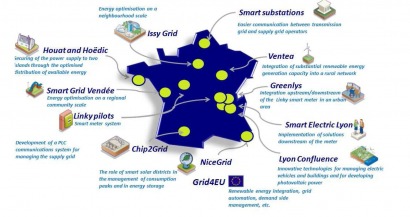
ERDF, which manages fully 95 percent of France’s electric power infrastructure, said in a recent white paper that such collaborations are necessary because much of what’s needed to bring a new era of smart grids into being falls beyond the usual scope of major utility companies.
The effort, comprised of demonstration initiative, pure partnerships and cross-cutting actions have been developed with leading market players, together with universities, major corporations and even startups.
In carrying out these initiatives, ERDF said it has positioned itself at the forefront of smart grid development n France, and that’s helped to dramatically increase the reliability of the existing distribution as well.
According to ERDF, in the early 1980s, the average outage time in France was about 400 minutes per customer per year. Now, as a result of the natural evolution of technology and the march toward smarter grids with more transparency, the average outage time is down to about 60 minutes per customer per year.
The first step in implementing the initiative was the roll-out of ERDF’s “Linky” system, a combination of 750,000 concentrators and 35 million meters, that ensure close management of all public supply grids. Then came the implementation GRID4EU and other demonstration projects.
Officially launched on 22 November 2011 with a budget of €54 million, GRID4EU is currently the biggest ongoing smart grid demonstration programme in Europe.
It is coordinated by ERDF and involves six leading European DSOs -- ERDF (France), ENEL (Italy), IBERDROLA (Spain), RWE (Germany), VATTENFALL (Sweden) and CEZ (Czech Republic. Together, these companies supply 50% of all electricity consumers in the European Union.
Through the partnership the firms have combined their complementary strengths and capabilities and to share the results of their work rather than conduct their own individual experiments. Areas they are striving to address include increased grid automation; integration of renewable energy sources (primarily photovoltaic and wind power); active demand side management and development of load-shedding solutions; introduction of electric and hybrid vehicles; and incorporation of energy storage solutions.
Companies participating in the initiative include Cisco, Siemens, ABB, and Alstom.
The consortium has given itself four years to complete the project, and to present its conclusions to the entire European Union.
Other projects include:
IssyGri -- which aims to optimize performance in electricity generation through the creation of eco-districts and smart cities; implementation of consumption/production management software, installation of photovoltaics, cogeneration; advanced building management systems, and the aforementioned Linky mart meter system.
Houat and Hoëdic -- a project to secure the power supply to two islands situated off the Morbihan coast, which are supplied via an undersea cable and a generator set that is not sized to peak demand. The purpose of the demonstration initiative is to restore power to geographically-isolated places whose medium voltage supply has been cut off.
Smart Grid Vendée -- this project aims to demonstrate that greater overall energy efficiency can be achieved by taking better account of local factors in public supply grid management and therefore integrating renewable energy sources into supply grids while more efficiently controlling grid development and improvement costs through measures to enhance the flexibility of distributed energy resources (consumption, production).
Chip2Grid -- This demonstration project is investigating the use of G3-PLC to increase the observability and "controllability" of grids, with the ultimate aim of developing a G3-PLC communications system to facilitate the "real-time" management of supply grids.
Lyon Confluence -- The purpose of this project is to implement innovative technologies for managing electric vehicles (fast and slow charging points for a fleet of around 40 vehicles) and buildings (introduction of building management systems for several buildings), and to develop the use of photovoltaic power in a selected block of buildings.
Smart Electric Lyon -- This project aims to test various smart, innovative and attractive solutions in a group of almost 10,000 consumers, in order to introduce greater flexibility into their electricity consumption patterns in response to economic signals communicated via the Linky smart meter system.
Greenlys -- Integration of upstream/downstream experiments in urban areas (roll-out of the Linky meter, Linky Grid, renewable energy integration, rechargeable electric and hybrid vehicles, energy storage solutions, automated grid management, upstream/downstream optimisation and interoperability via an aggregator, etc.). Greenlys draws on the combined expertise of several industrial partners, and brings together numerous smart grid experts.
It is supported by the cities of Lyon and Grenoble, whose ambitions to promote energy efficiency and become "sustainable cities" are very well known.
Venteaa -- A consortium of industrial companies, schools and universities coordinated by ERDF to test the medium voltage network of the future. The goal is to create the right conditions for integrating renewable energy sources, particularly wind and photovoltaic power, into a rural network in an economically and technically efficient manner.
Smart substations -- The "Smart Substations" project is a showcase of expertise in digital source substations. It aims to develop and test an open-standard digital interface for source substations, in order to connect the respective control and command systems of RTE and ERDF and hence facilitate exchanges, safely upload new data to central information systems, and develop and test solutions for using RTE's optical fibre network in the remote management of source substations.
For additional information:

